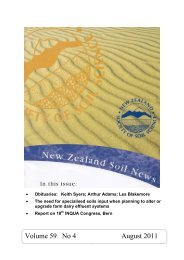Download - New Zealand Society of Soil Science
Download - New Zealand Society of Soil Science
Download - New Zealand Society of Soil Science
Create successful ePaper yourself
Turn your PDF publications into a flip-book with our unique Google optimized e-Paper software.
anticipate. He was persuaded to undertake the work by <strong>of</strong>ficials who clearly pointed out that no-one<br />
else was better qualified than he because <strong>of</strong> his understanding <strong>of</strong> the soil and landscape properties that<br />
lay at the heart <strong>of</strong> the “East Coast problem”.<br />
Norman Taylor's talk and the subsequent discussions unconsciously, but neatly, foreshadowed the<br />
misgivings that many soil scientists have had, about their dealings with central and local government,<br />
commercial and legal parties and communities. The context we work in has been fundamentally<br />
changed however and many current concerns exist in the border areas between agricultural production<br />
and environmental protection because soils are used by people and are changed because <strong>of</strong> that use.<br />
Concepts like equilibrium states begin to lose relevance as human activity influences the soil forming<br />
factors and more or less continuous change occurs. Many soil scientists have responded to the<br />
changed context pragmatically, as Norman Taylor did, but <strong>of</strong>ten remain deeply uncomfortable about<br />
moving outside strict discipline boundaries. Much <strong>of</strong> the tension around these issues arises from the<br />
different standards <strong>of</strong> evidence that are acceptable to different groups. Scientists have attitudes toward<br />
objectivity and uncertainty that are <strong>of</strong>ten inconvenient in the wider world.<br />
<strong>Soil</strong>s are changed by human use. Some <strong>of</strong> the changes can be predicted and measured. Some can be<br />
managed or mitigated in an informed way. Others changes are poorly understood and the potential for<br />
unknown effects always exists in the complex ecological setting that soil provides. As conflicts over<br />
the use <strong>of</strong> soil and water grow so does the volume <strong>of</strong> data, information, opinion and propaganda from<br />
interest groups that the soil science community needs to assimilate, contribute to, criticise or debunk.<br />
Three examples <strong>of</strong> the interaction between soils and human activity are now discussed:<br />
1. Cultivation history can be an important agent in determining the distribution <strong>of</strong> soil processes<br />
across landscapes. Nitrification is one <strong>of</strong> these processes and can exert subtle but powerful change in<br />
soil properties. In some areas at least it will be in farmers' interest to understand the status <strong>of</strong><br />
nitrification in their soils<br />
2. Two perceptions <strong>of</strong> the soil resource and the importance <strong>of</strong> knowing the history <strong>of</strong> resources in<br />
a consideration <strong>of</strong> their future.<br />
3. The question “Is there money in the (soil) bank?” is used to consider the value <strong>of</strong> the soil<br />
resource to the <strong>New</strong> <strong>Zealand</strong> economy,<br />
1. Cultivation as an agent <strong>of</strong> change<br />
Over the past decade the movement <strong>of</strong> nitrogen (N) from grassland farms to surface or subsurface<br />
water has become a matter <strong>of</strong> public policy interest. Methods for managing or mitigating this have<br />
been widely pursued in publicly and commercially funded research programmes. Public policy has<br />
also begun to focus on planning to reduce current loadings <strong>of</strong> N in catchments or to limit future growth<br />
<strong>of</strong> those N loads. Farmers have a new interest in determining whether or not the properties <strong>of</strong> their<br />
soils and landscapes are being accurately represented (or at least not over-assessed) in, or by, the<br />
models used to predict N loss from their farms. Equity becomes an important issue in all <strong>of</strong> these<br />
deliberations and this produces some important changes for the soil science community.<br />
The assumptions made in the nutrient budgets or process models that are used to define N losses from<br />
farms become very important in this context. Nitrification is assumed to be an active process in<br />
almost all cases and this pr<strong>of</strong>oundly affects the estimates <strong>of</strong> N loss from farms. This view tends to<br />
neglect the influence <strong>of</strong> cultivation, but the history <strong>of</strong> agriculture is essentially a history <strong>of</strong> cultivation<br />
<strong>of</strong> soils. Cultivation is the means to establish a crop and also the means to enhance nutrient supply to<br />
it. Cultivation turns the combined nutrients in the soil organic matter, a natural capital stock, into a<br />
liquid asset. The tyranny <strong>of</strong> topography has meant that the agricultural exploitation <strong>of</strong> the <strong>New</strong><br />
49










